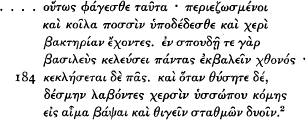Notes and Observations
The Usage of שש and עןכ in the Bible and its Implication for the Date of P
-
- Published online by Cambridge University Press:
- 10 June 2011, pp. 117-121
-
- Article
- Export citation
A Note on Theodotus' Description of Shechem
-
- Published online by Cambridge University Press:
- 10 June 2011, pp. 221-227
-
- Article
- Export citation
Research Article
Notes on the Text and Metre of Ezekiel the Tragedian's Exagôgê
-
- Published online by Cambridge University Press:
- 10 June 2011, pp. 449-457
-
- Article
- Export citation
Liturgical Traditions in Mic. 7
-
- Published online by Cambridge University Press:
- 10 June 2011, pp. 349-367
-
- Article
- Export citation
Notes and Observations
On the “Faith of Christ”
-
- Published online by Cambridge University Press:
- 10 June 2011, pp. 459-465
-
- Article
- Export citation
The Ascription of Romans 4:5
-
- Published online by Cambridge University Press:
- 10 June 2011, pp. 228-230
-
- Article
- Export citation
Books Received
Books Received
-
- Published online by Cambridge University Press:
- 10 June 2011, pp. 369-371
-
- Article
- Export citation
Notes and Observations
The Date of the Oration of Tatian
-
- Published online by Cambridge University Press:
- 10 June 2011, pp. 123-126
-
- Article
- Export citation
Books Received
Books Received
-
- Published online by Cambridge University Press:
- 10 June 2011, pp. 231-233
-
- Article
- Export citation
Notes and Observations
שונא םרח in Isaiah 8:1
-
- Published online by Cambridge University Press:
- 10 June 2011, pp. 465-468
-
- Article
- Export citation
Books Received
Books Received
-
- Published online by Cambridge University Press:
- 10 June 2011, pp. 127-131
-
- Article
- Export citation
Front matter
HTR volume 60 issue 3 Cover and Front matter
-
- Published online by Cambridge University Press:
- 10 June 2011, pp. f1-f2
-
- Article
-
- You have access
- Export citation
Notes and Observations
Notes on the Dating of the Non-Massoretic Psalms of IIQPsa
-
- Published online by Cambridge University Press:
- 10 June 2011, pp. 468-476
-
- Article
- Export citation
Front matter
HTR volume 60 issue 1 Cover and Front matter
-
- Published online by Cambridge University Press:
- 10 June 2011, pp. f1-f2
-
- Article
-
- You have access
- Export citation
HTR volume 60 issue 2 Cover and Front matter
-
- Published online by Cambridge University Press:
- 10 June 2011, pp. f1-f2
-
- Article
-
- You have access
- Export citation
Back matter
HTR volume 60 issue 3 Cover and Back matter
-
- Published online by Cambridge University Press:
- 10 June 2011, pp. b1-b2
-
- Article
-
- You have access
- Export citation
HTR volume 60 issue 2 Cover and Back matter
-
- Published online by Cambridge University Press:
- 10 June 2011, pp. b1-b3
-
- Article
-
- You have access
- Export citation
Notes and Observations
The Function of Promissio in Luther's Commentary on Romans
-
- Published online by Cambridge University Press:
- 10 June 2011, pp. 476-482
-
- Article
- Export citation
Back matter
HTR volume 60 issue 1 Cover and Back matter
-
- Published online by Cambridge University Press:
- 10 June 2011, pp. b1-b2
-
- Article
-
- You have access
- Export citation
Notes and Observations
On the Athanasian Creed
-
- Published online by Cambridge University Press:
- 10 June 2011, pp. 483-484
-
- Article
- Export citation

